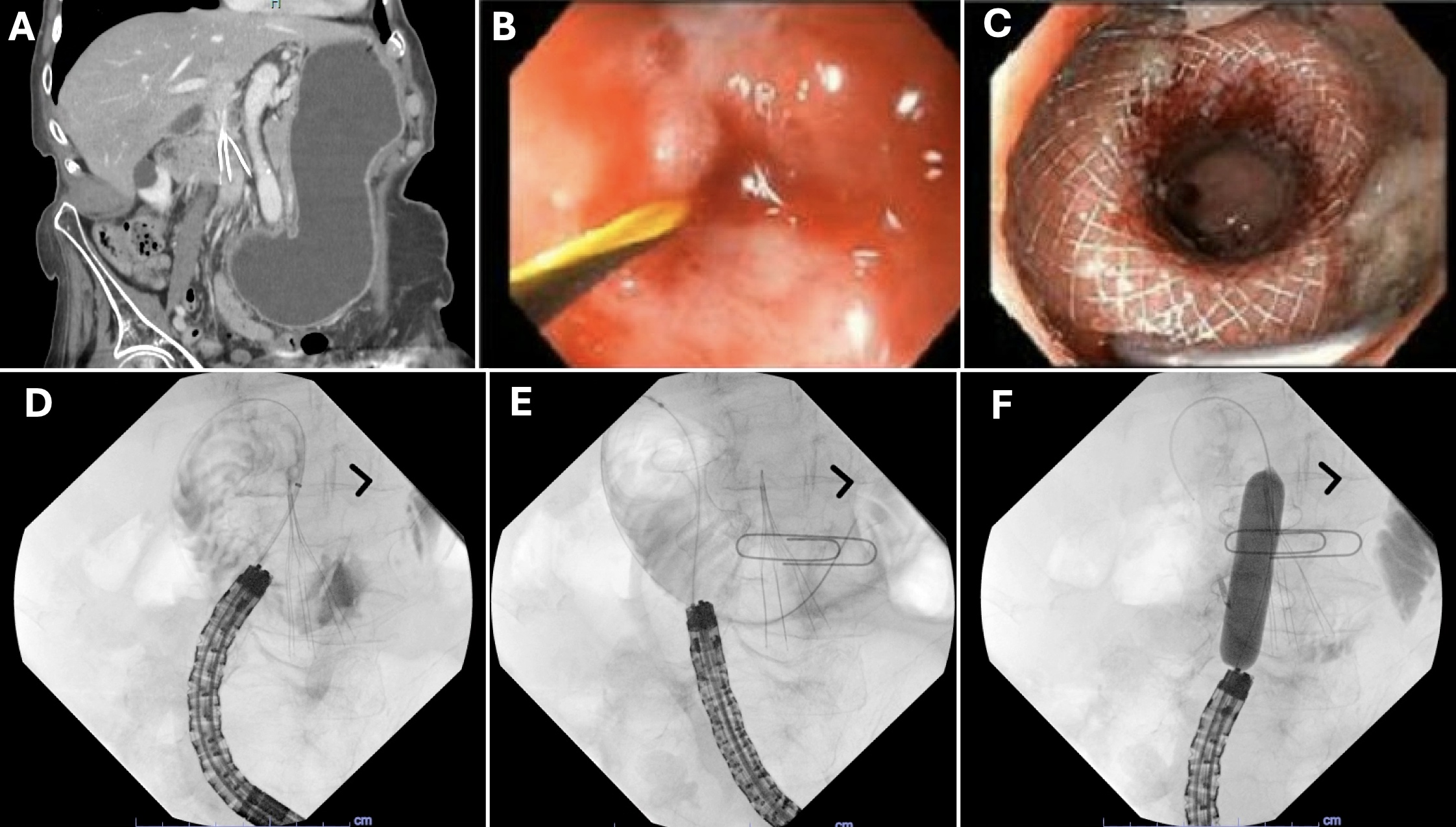Sunday Poster Session
Category: Interventional Endoscopy
P1115 - Lumen-Apposing Metal Stents (LAMS) for Managing Pyloric Stenosis
Sunday, October 27, 2024
3:30 PM - 7:00 PM ET
Location: Exhibit Hall E

Has Audio

Syed Hamza Sohail, MD
University of Massachusetts Chan Medical School - Baystate Health
Springfield, MA
Presenting Author(s)
Syed Hamza Sohail, MD1, Kevin Groudan, MD2, Syed Hammad Kazmi, MD3, Tushaar V. Shrimanker, MD, MRCP4, Nha Duong, DO4
1University of Massachusetts Chan Medical School - Baystate Health, Springfield, MA; 2University of Massachusetts Chan Medical School - Baystate, Springfield, MA; 3Robert Wood Johnson University Hospital, Bronx, NY; 4University of Massachusetts Chan Medical School - Baystate Medical Center, Springfield, MA
Introduction: Current guidelines recommend management of benign gastric outlet obstruction (GOO) with serial dilations. However, dilation can often be complicated by recurrent stenosis. Self-expanding metal stents have been used in benign pyloric obstruction with good symptomatic relief however there is a high rate of stent migration. Lumen-apposing metal stents (LAMS) are sometimes used in an off-label manner for treating GI luminal strictures. We present a case of pyloric stenosis successfully managed with LAMS placement.
Case Description/Methods: 69-year-old female with a past medical history of cerebral palsy, DVT with IVC filter placement, esophagitis, presented to the hospital with nausea, vomiting and decreased oral intake. Patient had a known history of benign pyloric stenosis requiring serial dilations, with her last endoscopy being 15 months ago. CT imaging showed a severely distended fluid filled stomach to the level of the pylorus likely reflecting recurrent pyloric stenosis. She underwent esophagogastroduodenoscopy (EGD) that demonstrated grade D esophagitis, large amount of food content in the stomach, and benign appearing severe pyloric stenosis with no opening visible. Patient was brought back for repeat EGD under fluoroscopy. A catheter was passed in the area of the pyloric opening. A wire and balloon were advanced and contrast injection confirmed placement within lumen. The stricture was found to be less than 1 cm in length. A 20mm x 10mm LAMS was advanced and deployed so the body traversed the pyloric stricture. The axios stent was anchored with 2 mantis clips and then dilated to 15mm using balloon dilation. The scope was then able to traverse into the first portion of the duodenum. Patient had resolution of nausea and vomiting, and she tolerated a low residue diet well before she was discharged home.
Discussion: While the use of LAMS for benign GOO is not standard of care, there is a growing pool of data that highlights it as an effective option for managing these patients. The short length and wide flanges make LAMS suitable for this indication and may reduce the number of endoscopies required for repeated dilations. LAMS appear to be safe when used to treat GI luminal strictures with a recent study showing only 2 out of 138 cases having an immediate adverse event. However more data with long term follow up and randomized control trails are needed to further determine the possible role of LAMS in routine management of benign pyloric stenosis.

Disclosures:
Syed Hamza Sohail, MD1, Kevin Groudan, MD2, Syed Hammad Kazmi, MD3, Tushaar V. Shrimanker, MD, MRCP4, Nha Duong, DO4. P1115 - Lumen-Apposing Metal Stents (LAMS) for Managing Pyloric Stenosis, ACG 2024 Annual Scientific Meeting Abstracts. Philadelphia, PA: American College of Gastroenterology.
1University of Massachusetts Chan Medical School - Baystate Health, Springfield, MA; 2University of Massachusetts Chan Medical School - Baystate, Springfield, MA; 3Robert Wood Johnson University Hospital, Bronx, NY; 4University of Massachusetts Chan Medical School - Baystate Medical Center, Springfield, MA
Introduction: Current guidelines recommend management of benign gastric outlet obstruction (GOO) with serial dilations. However, dilation can often be complicated by recurrent stenosis. Self-expanding metal stents have been used in benign pyloric obstruction with good symptomatic relief however there is a high rate of stent migration. Lumen-apposing metal stents (LAMS) are sometimes used in an off-label manner for treating GI luminal strictures. We present a case of pyloric stenosis successfully managed with LAMS placement.
Case Description/Methods: 69-year-old female with a past medical history of cerebral palsy, DVT with IVC filter placement, esophagitis, presented to the hospital with nausea, vomiting and decreased oral intake. Patient had a known history of benign pyloric stenosis requiring serial dilations, with her last endoscopy being 15 months ago. CT imaging showed a severely distended fluid filled stomach to the level of the pylorus likely reflecting recurrent pyloric stenosis. She underwent esophagogastroduodenoscopy (EGD) that demonstrated grade D esophagitis, large amount of food content in the stomach, and benign appearing severe pyloric stenosis with no opening visible. Patient was brought back for repeat EGD under fluoroscopy. A catheter was passed in the area of the pyloric opening. A wire and balloon were advanced and contrast injection confirmed placement within lumen. The stricture was found to be less than 1 cm in length. A 20mm x 10mm LAMS was advanced and deployed so the body traversed the pyloric stricture. The axios stent was anchored with 2 mantis clips and then dilated to 15mm using balloon dilation. The scope was then able to traverse into the first portion of the duodenum. Patient had resolution of nausea and vomiting, and she tolerated a low residue diet well before she was discharged home.
Discussion: While the use of LAMS for benign GOO is not standard of care, there is a growing pool of data that highlights it as an effective option for managing these patients. The short length and wide flanges make LAMS suitable for this indication and may reduce the number of endoscopies required for repeated dilations. LAMS appear to be safe when used to treat GI luminal strictures with a recent study showing only 2 out of 138 cases having an immediate adverse event. However more data with long term follow up and randomized control trails are needed to further determine the possible role of LAMS in routine management of benign pyloric stenosis.

Figure: Figures A - F:
A: CT abdomen
B: Pylorus before LAMS placement
C: Pylorus after LAMS placement
D: Pyloric stenosis on fluoroscopy
E: LAMS deployment
F: Balloon dilation to 15mm
A: CT abdomen
B: Pylorus before LAMS placement
C: Pylorus after LAMS placement
D: Pyloric stenosis on fluoroscopy
E: LAMS deployment
F: Balloon dilation to 15mm
Disclosures:
Syed Hamza Sohail indicated no relevant financial relationships.
Kevin Groudan indicated no relevant financial relationships.
Syed Hammad Kazmi indicated no relevant financial relationships.
Tushaar Shrimanker indicated no relevant financial relationships.
Nha Duong indicated no relevant financial relationships.
Syed Hamza Sohail, MD1, Kevin Groudan, MD2, Syed Hammad Kazmi, MD3, Tushaar V. Shrimanker, MD, MRCP4, Nha Duong, DO4. P1115 - Lumen-Apposing Metal Stents (LAMS) for Managing Pyloric Stenosis, ACG 2024 Annual Scientific Meeting Abstracts. Philadelphia, PA: American College of Gastroenterology.
